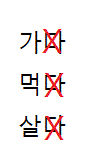In this post, I am talking about how to conjugate verbs and adjectives from basic verb forms.
Every Korean verb/adjective ends with ‘— 다’, for example, 가다, 오다, 먹다, 살다, 마시다 etc. When you conjugate verbs/adjectives with endings, first you delete 다 and then add endings like the following below.

And then you have to look at an ending that you want to add. There are three types of endings. The first type is -아/어/여 ending. For -아/어/여 ending, you have to look at the previous letter’s vowel.
If the vowel is ㅏor ㅗ, then you have to add -아. For example, -아요(present), -았어요(past), -아서(because) etc.
If the vowel is other than ㅏ or ㅗ, you have to add -어. For example, -어요(present), -었어요(past), -어서(because) etc.
If the previous letter ends with ‘하’, you have to add -여. But it changes the form into ‘해’ in conversations. For example, -여요=>해요(present), -였어요=> 했어요(past), -여서=> 해서(because).
The second type is that endings start with -(으) or (스), for example, (으)ㄹ 거예요, (으)ㄹ 수 있어요, -(스)ㅂ니다 etc. In this case, you have to look at whether the previous letter ends with a vowel or a consonant.
If the letter ends with a vowel, you do not use 으 or 스. For example, 가+ㅂ니다 => 갑니다, 자+ㄹ 거예요 => 잘 거예요.
If the letter ends with a consonant, you have to use 으 or 스. For example, 먹+습니다 => 먹습니다, 읽+습니다 => 읽습니다.

Finally, the third type is that endings start with a consonant. For example, -고, -지, -게 etc. For these endings, you can just simply attach them to a verb/adjective.
가+고 싶어요 => 가고 싶어요, 먹+지 않아요 => 먹지 않아요.
Please reply to this post if you have any questions about conjugation. Thank you!

Thank you for your work. I have recently started to study with this website and i like it so much. Waiting for more information and reading texts!